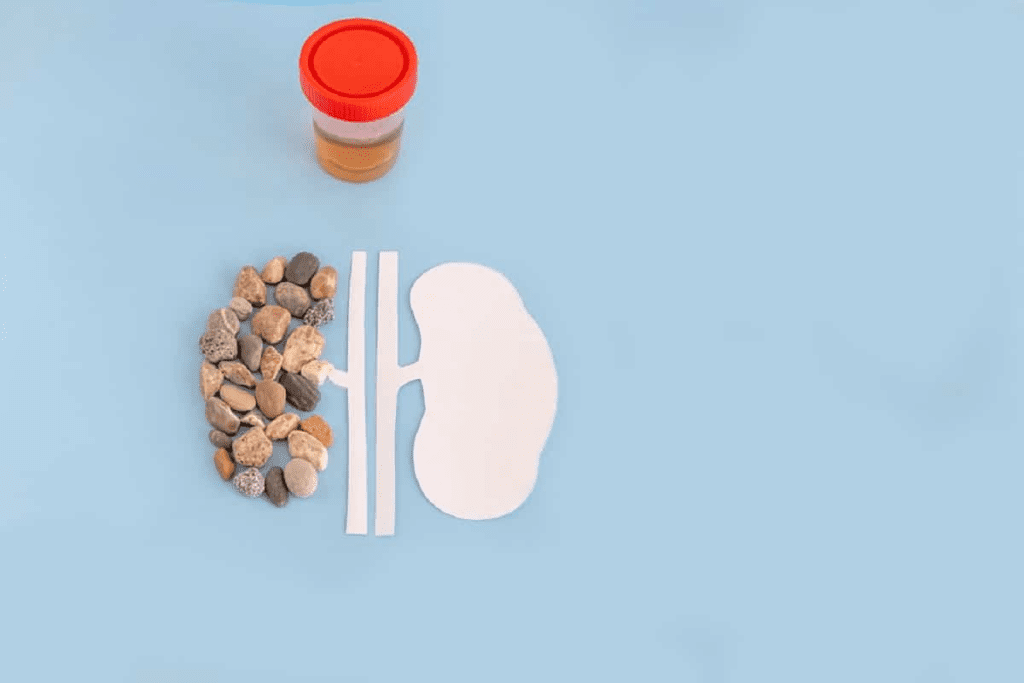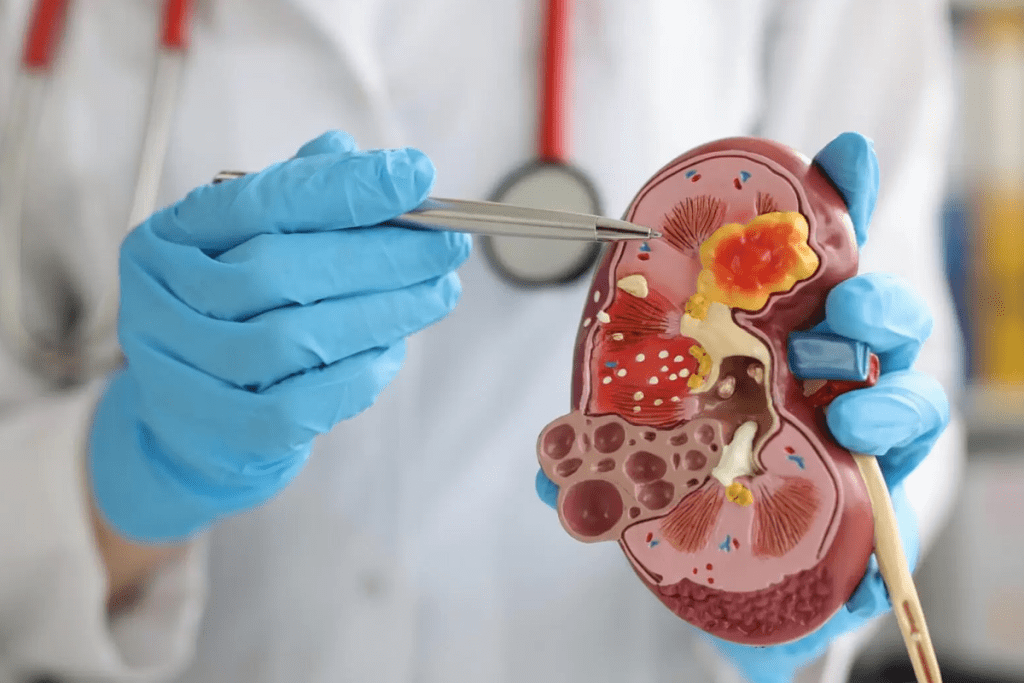Last Updated on October 31, 2025 by

Bato (Kidney stones), also known as nephrolithiasis, are a painful condition that affects millions worldwide. These clusters of crystals form from minerals and other substances in the urinary tract. They cause severe pain as they move through the body.
Recent advances in kidney stone management have made it possible to clear stones within days. This is true for moderate to large stones. We aim to provide effective and quick treatment options for those suffering from kidney stone symptoms.
It’s important to understand what causes kidney stones to choose the right treatment. We’ll look at various treatment options. These include minimally invasive surgeries and laser technologies.
It’s important to know about kidney stones to treat and prevent them. These stones are common and affect many people globally.
Kidney stones form when minerals and substances in urine concentrate. This concentration leads to stone formation.
Many things can cause kidney stones. Too much calcium or uric acid in the blood and genetic conditions like cystinuria are common causes. Diet also plays a big role.
Genetic conditions, like cystinuria, can also lead to stone formation. This condition affects how cystine is transported in the kidneys, causing cystine stones.
Symptoms of kidney stones vary based on stone size and location. Common signs include severe pain, nausea, and vomiting.
“The pain of a kidney stone is often described as one of the most severe pains experienced by humans, often radiating from the back and flank to the lower abdomen and groin.”
Other symptoms include:
Spotting these symptoms early is key to getting medical help and avoiding complications.

New surgical methods have made treating kidney stones better. They help patients recover faster. We’ll look at PCNL, mini-PCNL, and RIRS. Each is designed to tackle different kidney stone issues.
PCNL is great for big kidney stones. It makes a small cut in the back and puts a tube into the kidney. This breaks up and removes the stone.
PCNL works well for big stones that can’t pass on their own. It has a success rate of up to 90% for some stones.
Mini-PCNL is like PCNL but with smaller cuts. It causes less damage and heals faster. It’s for patients with smaller stones or those needing less invasive treatment.
Mini-PCNL has less blood loss, less pain, and shorter stays in the hospital. It’s a better option for many patients.
RIRS uses a flexible scope to reach the kidney. A laser breaks the stone into small pieces. These pieces can then pass out of the body.
RIRS is great because it’s very effective and doesn’t hurt much. Patients often go home the same day or the next day.

These new surgical methods have changed how we treat kidney stones. They offer effective treatments with fewer side effects and quicker recovery. Knowing about each procedure helps patients make better choices for their care.
Advanced laser technologies are changing how we treat kidney stones. They offer a quicker and more effective way to deal with these issues. Now, we have new treatments that help with kidney stone pain and speed up recovery.
High-frequency laser lithotripsy is a new method for breaking down kidney stones. It turns stones into small pieces that can pass easily. This is done with a laser fiber that sends high-energy waves to the stone.
This method is precise, which means less damage to nearby tissues. It’s also great for stones that don’t respond well to other treatments.
Laser treatment for nephrolithiasis has many advantages. It’s less invasive, which means less pain and quicker healing. It also works well, with a high success rate in clearing stones.
Patients often feel less pain and discomfort as the stones are broken down. The risk of complications from traditional surgery is also lower.
With advanced laser technologies, we can offer a safe, effective, and fast treatment for kidney stones. This is a big step forward in managing nephrolithiasis, giving hope to those affected.
Medical therapy aims to speed up kidney stone passage. We’ll look at different treatments to manage kidney stones. These treatments help stones move and ease symptoms.
Alpha blockers relax the muscles in the ureter. This makes it easier to pass kidney stones. They reduce muscle tone, speeding up stone passage and easing kidney pain.
Medical expulsive therapy (MET) uses alpha blockers to help stones pass. It’s most effective for smaller stones.
Managing kidney pain is key during stone passage. Pain meds help ease discomfort. NSAIDs and opioids are common choices.
It’s important to use pain meds wisely. They should be used under a doctor’s watch to avoid side effects and addiction.
Medical therapies can help, but they have limits. They might not work for big stones or those causing blockages.
In these cases, more serious treatments like surgery or lithotripsy might be needed. Knowing all kidney stone treatment options is important for effective care.
Understanding kidney stone causes and treatments helps make better care choices. We’ll look at new treatments in the next sections.
The world is seeing big changes in how we treat kidney stones. New, less invasive methods are being used. These changes aim to make recovery faster and results better. They come from research and innovation worldwide, with some countries leading the way.
Turkey is a leader in treating kidney stones with new methods. Places like Liv Hospital are using the latest research to help patients. Their work helps set the standard for kidney stone treatment globally.
The size and where a kidney stone is located matter a lot. Smaller stones might go away with help, but bigger ones need more serious treatments. Knowing this helps doctors and patients choose the best treatment for nephrolithiasis.
By looking at the stone’s details and using new treatments, patients get the best care. This focused approach is key to modern kidney stone treatment. It shows a move towards treating each person as an individual in urology.
Kidney stones can be very painful and frustrating. But with the right treatment, patients can find quick relief. We’ve talked about different treatments, like surgeries and laser technologies that quickly break down stones.
It’s important to know what causes and symptoms of kidney stones are. This knowledge helps patients make smart choices about their care. By understanding symptoms and treatment options, patients can manage their condition well.
Managing pain from kidney stones is a big part of treatment. With help from healthcare professionals, patients can choose the best treatment. This helps them reduce pain and find relief.
Kidney stones form when minerals and substances in urine concentrate. Diet, genetics, and medical conditions play a role.
Symptoms include severe pain, nausea, and vomiting. You might also feel pain or burning when you pee, pee a lot, or see blood in your urine.
Treatments include PCNL, mini-PCNL, RIRS, and laser technologies. Medical therapies are also used.
PCNL is a surgery to remove big kidney stones. It involves a small incision in the back and a tube to reach the kidney.
Laser technologies break down stones into small pieces. This makes them easier to pass, reducing recovery time and complications.
Alpha blockers relax the ureter muscles. This helps stones pass more easily. They’re used to speed up stone passage.
Medical therapies like alpha blockers work for some stones. But, they might not work for big stones or those stuck in the tract. Surgery or laser tech might be needed then.
Treatment depends on the stone’s size, location, and the patient’s health. Stone type and any medical conditions are also considered.
Nephrolithiasis is the medical term for kidney stones. It means stones are in the kidneys or urinary tract.
Some risk factors can’t be changed, but diet and lifestyle can help. Drinking water, eating less sodium, and avoiding high-oxalate foods can prevent stones.
Subscribe to our e-newsletter to stay informed about the latest innovations in the world of health and exclusive offers!